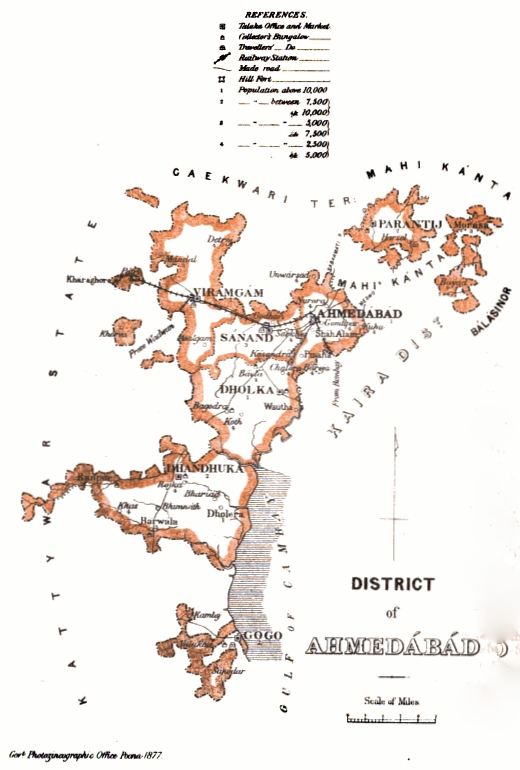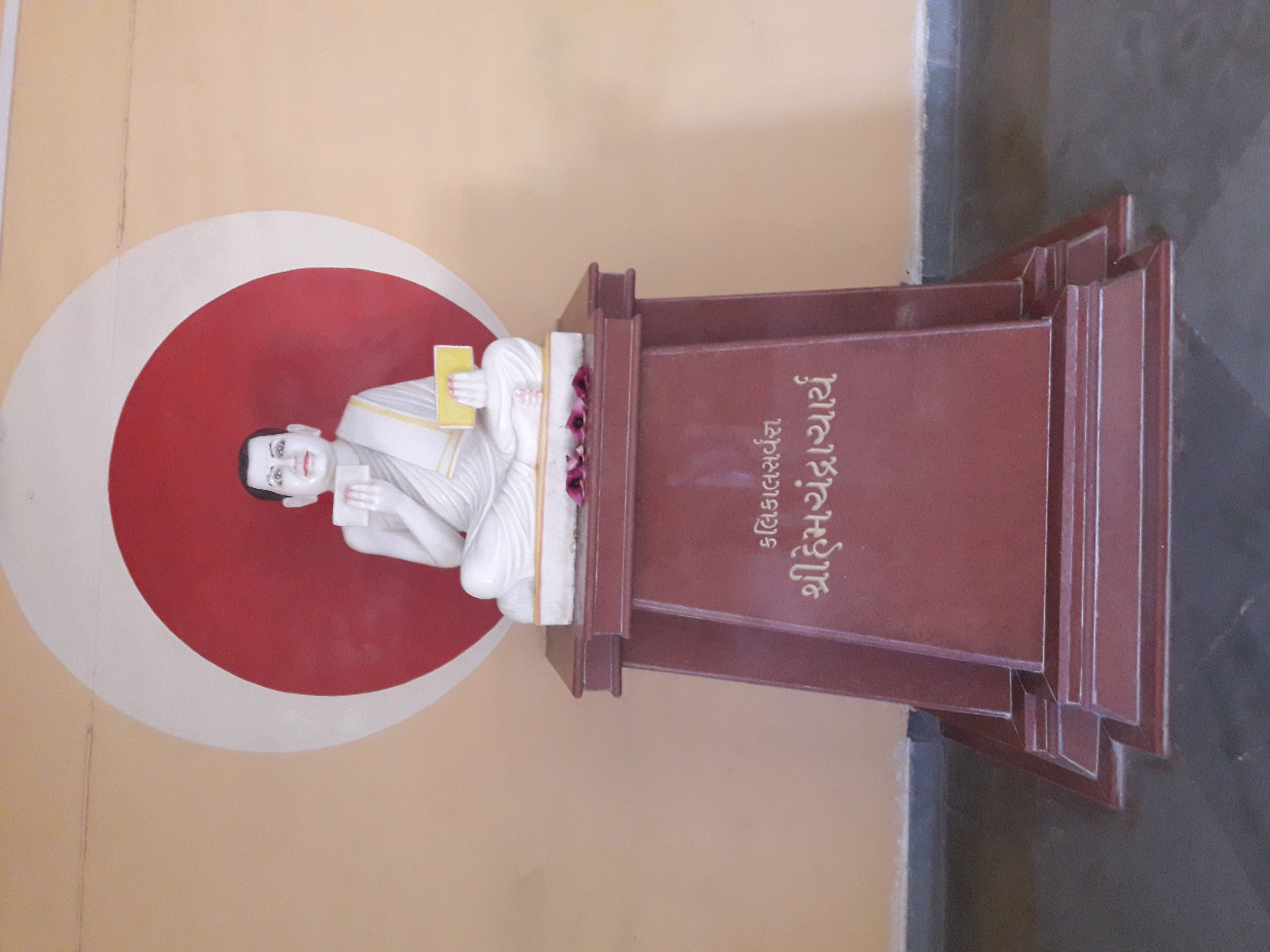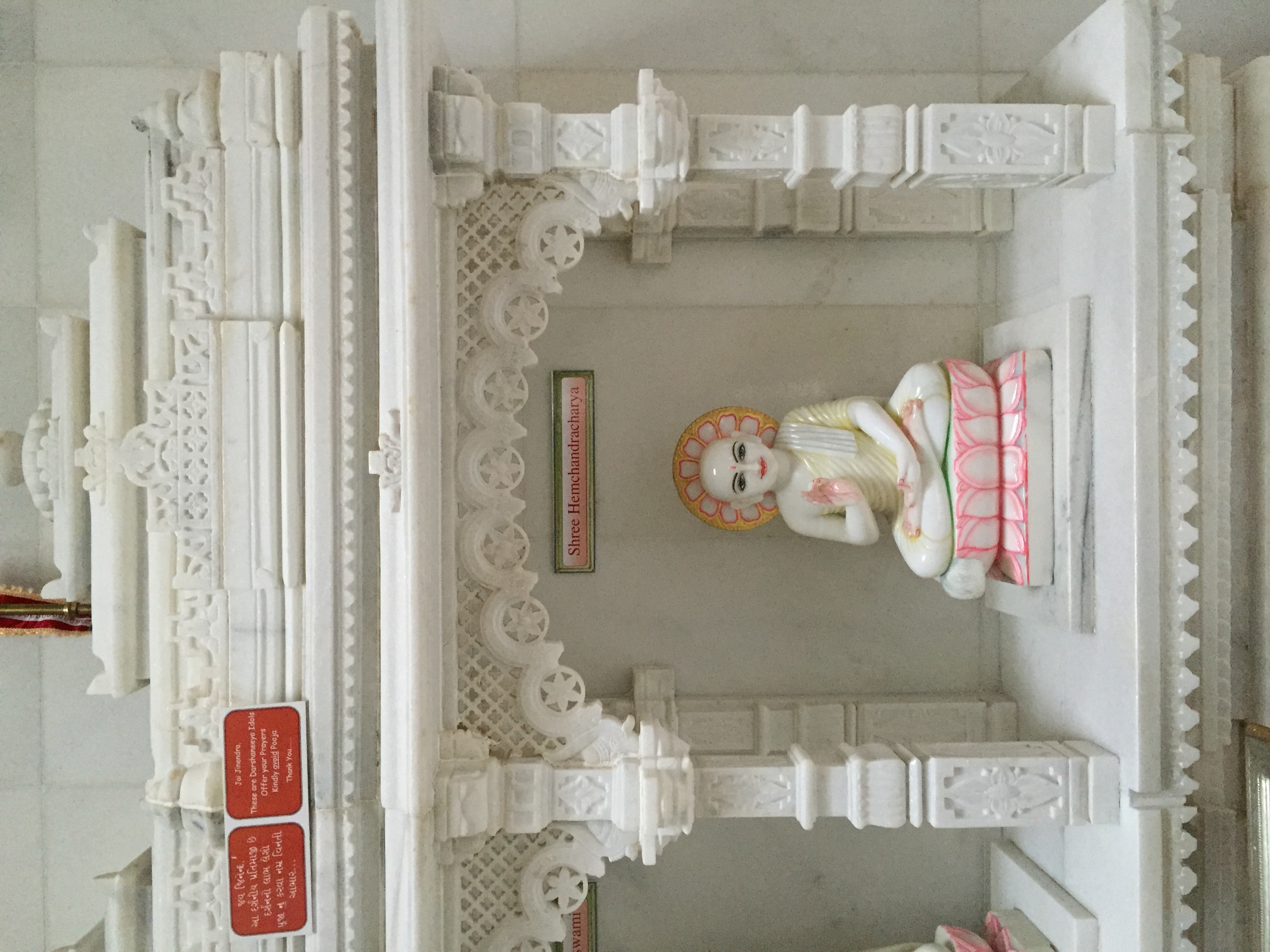|
Dhandhuka
Dhandhuka is a city and a municipality in the Ahmedabad district in the state of Gujarat, India. Moreover, it is a part of the Bhal region. History In the twelfth century, Dhandhuka became famous as the birthplace of the great Jain teacher Hemchandra and in his honor, Chaulukya king Kumarapala (Chaulukya dynasty), Kumarapala (1143–1174) raised a temple over his birthplace. Under the Muslims and Marathas, Dhandhuka kept its position as a country town, its fortune is almost always linked with the fortune of Dholka. Along with Dholka, it was ceded to the British in 1802. Chudasama dynasty, Chudasama Rajputs of Dhandhuka were the descendants of the ancient and princely line of Junagadh. A younger son of one of the Ra of Sorath, named Bhimji, is said to have received, as his patrimony, four "chorashees," or districts, each containing eighty-four villages; one of which, the district of Dhandhuka, was inherited by his son, Raysalji. From Merjee, the ' fourth son of Raysalji, descen ... [...More Info...] [...Related Items...] OR: [Wikipedia] [Google] [Baidu] |
Dhandhuka (tehsil)
Dhandhuka is a taluka of Ahmedabad District, India. A taluka is a district subdivision in India that is in charge of managing and collecting taxes for a specific area inside the district. Dhandhuka is capital of Dhandhuka Taluka. Population It has a population o30,049f the total population, 22.36% reside in rural areas and 77.64% in urban areas. In Dhandhuka Taluka, 8.38% of the population is Scheduled Caste (SC) and 0.24 % is Scheduled Tribe (ST). Dhandhuka Religion Population Dhandhuka Urban & Rural Population Out of total population, 50% of population lives in Urban area and 60% lives in Rural area List of Cities in Dhandhuka Below is a comprehensive list of all town cities of Dhandhuka district. List of Villages in Dhandhuka References Talukas of Gujarat Ahmedabad district {{Ahmedabad-geo-stub ... [...More Info...] [...Related Items...] OR: [Wikipedia] [Google] [Baidu] |
Ahmedabad District
Ahmedabad (Amdavad) district is a district comprises the city of Ahmedabad, in the central part of the state of Gujarat in western India. It is the seventh most populous district in India (out of 739). Ahmedabad District Surrounded By Kheda district in the east, Mehsana district in the north, Anand district in the south and Surendranagar district in the west. Etymology The area around Ahmedabad has been inhabited since the 11th century, when it was known as '' Ashaval''. At that time, Karna, the Chaulukya (Solanki) ruler of Anhilwara (modern Patan), waged a successful war against the Bhil king of Ashaval, and established a city called ''Karnavati'' on the banks of the Sabarmati. In 1411, this area came under the control of Muzaffar Shah I's grandson, Sultan Ahmed Shah, who selected the forested area along the banks of the Sabarmati river for a new capital city. He laid the foundation of a new walled city near Karnavati and named it Ahmedabad after himself. According to ... [...More Info...] [...Related Items...] OR: [Wikipedia] [Google] [Baidu] |
Dhandhuka (Vidhan Sabha Constituency)
Dhandhuka is one of the 182 Legislative Assembly constituencies of Gujarat state in India. It is part of Ahmedabad district. List of segments This assembly seat represents the following segments, # Dhandhuka Taluka # Ranpur Taluka # Barwala Taluka # Dholera taluka Members of Legislative Assembly Election results 2022 --> 2017 2012 2007 2002 See also * List of constituencies of the Gujarat Legislative Assembly * Ahmedabad district Ahmedabad (Amdavad) district is a district comprises the city of Ahmedabad, in the central part of the state of Gujarat in western India. It is the seventh most populous district in India (out of 739). Ahmedabad District Surrounded By Kheda dis ... References External links * {{coord, 22.38, 71.98, display=title Assembly constituencies of Gujarat Ahmedabad district Politics of Gujarat Constituencies established in 1972 1972 establishments in Gujarat ... [...More Info...] [...Related Items...] OR: [Wikipedia] [Google] [Baidu] |
Sonang Mer
Thakor Sonangji Mer or Thakur Sonangji Mair was chief of Kolis. He came from Sindh to Dhandhuka. His son Dhandhal Khant was founder of Dhandhuka. He conquered the Dhandhuka Dhandhuka is a city and a municipality in the Ahmedabad district in the state of Gujarat, India. Moreover, it is a part of the Bhal region. History In the twelfth century, Dhandhuka became famous as the birthplace of the great Jain teacher He ... and founded Dhandhalpur. See also * Khant References Date of birth missing Date of death missing People from Sindh People from Gujarat {{India-bio-stub ... [...More Info...] [...Related Items...] OR: [Wikipedia] [Google] [Baidu] |
Dhandhuka (Lok Sabha Constituency)
Dhandhuka was a Lok Sabha constituency in Ahmedabad district of Gujarat, India. With the implementation of the delimitation of parliamentary constituencies in 2008, it ceased to exist. Members of Parliament *1952-66: ''Constituency does not exist'' *1967: R.K. Amin, Swatantra Party *1971: H. M. Patel, Swatantra Party *1977: Natverlal Parmar, Janata Party *1980: Narsingh Makwana, Indian National Congress *1984: Narsingh Makwana, Indian National Congress *1989: Ratilal Varma, Bharatiya Janata Party *1991: Ratilal Varma, Bharatiya Janata Party *1996: Ratilal Varma, Bharatiya Janata Party *1998: Ratilal Varma, Bharatiya Janata Party *1999: Ratilal Varma, Bharatiya Janata Party *2004: Ratilal Varma, Bharatiya Janata Party *2008 onwards: ''Constituency does not exist'' See also * Dhandhuka * List of constituencies of the Lok Sabha The Lok Sabha, the Lower House of the Parliament of India, is made up of Members of Parliament ( MPs). Each member of parliament represents ... [...More Info...] [...Related Items...] OR: [Wikipedia] [Google] [Baidu] |
Hemchandra
Hemacandra was a 12th century () Śvetāmbara Jaina ācārya, scholar, poet, mathematician, philosopher, yogi, grammarian, law theorist, historian, lexicographer, rhetorician, logician, and prosodist. Noted as a prodigy by his contemporaries, he gained the title ''kalikālasarvajña'', "the knower of all knowledge in his times" and is also regarded as father of the Gujarati language. Born as Caṅgadeva, he was ordained in the Śvetāmbara school of Jainism in 1110 and took the name Somacandra. In 1125 he became an adviser to King Kumārapāla and wrote ''Arhannīti'', a work on politics from Jaina perspective. He also produced ''Triśaṣṭi-śalākā-puruṣacarita'' (“Deeds of the 63 Illustrious Men”), a Sanskrit epic poem on the history of important figures of Jainism. Later when he was consecrated as ācārya, his name was changed to Hemacandra. Early life Hemacandra was born in Dhandhuka, in present-day Gujarat, on Kartika Sud Purnima (the full moon day of K� ... [...More Info...] [...Related Items...] OR: [Wikipedia] [Google] [Baidu] |
Hemchandracharya
Hemacandra was a 12th century () Śvetāmbara Jaina ācārya, scholar, poet, mathematician, philosopher, yogi, grammarian, law theorist, historian, lexicographer, rhetorician, logician, and prosodist. Noted as a prodigy by his contemporaries, he gained the title ''kalikālasarvajña'', "the knower of all knowledge in his times" and is also regarded as father of the Gujarati language. Born as Caṅgadeva, he was ordained in the Śvetāmbara school of Jainism in 1110 and took the name Somacandra. In 1125 he became an adviser to King Kumārapāla and wrote ''Arhannīti'', a work on politics from Jaina perspective. He also produced ''Triśaṣṭi-śalākā-puruṣacarita'' (“Deeds of the 63 Illustrious Men”), a Sanskrit epic poem on the history of important figures of Jainism. Later when he was consecrated as ācārya, his name was changed to Hemacandra. Early life Hemacandra was born in Dhandhuka, in present-day Gujarat, on Kartika Sud Purnima (the full moon day of Kār ... [...More Info...] [...Related Items...] OR: [Wikipedia] [Google] [Baidu] |
Bhal
The Bhal region is an area of Gujarat, India. It is spread across the political boundaries of the districts of Bhavnagar, Ahmedabad, and Anand. The Bhal region is situated on the deltas of the Sabarmati, Bhogawo, Bhadar, Lilka and other rivers that flow east and southeast off the Kathiawar peninsula into the Gulf of Cambay. The word Bhaal () () seems to have been derived from the Sanskrit word भाल which means forehead. Such a name is given to this region probably because it is mostly as flat as a forehead with almost entire region's soil without any stones, pebbles or gravel. Bhalia Wheat is a major farm cultivation in the region. Flowing through Bhal region ;Bhada (Bhaadar) ;Gautami ;Ghelo The Ghelo River starts near Babra in Amreli district and meets the Gulf of Cambay in the Bhal Region. ;Kalubhar The Kalubhar River starts near Babra in Amreli District and meets the Gulf of Cambay in the Bhal Region. The Rangholi River is a major tributary. ;Lilka ;Li ... [...More Info...] [...Related Items...] OR: [Wikipedia] [Google] [Baidu] |
Kumarapala (Chaulukya Dynasty)
Kumarapala () was a ruler from the Chaulukya (Solanki) dynasty of present-day western India. He ruled present-day Gujarat and surrounding areas, from his capital Anahilapataka (modern Patan). Kumarapala was a descendant of the Chaulukya king Bhima I. The information about him largely come from two sources – the numerous Sanskrit and Apabhramasa-Prakrit language inscriptions and the Jain texts. These provide a highly inconsistent historical profile in some respects, and corroborate each other in some. Both portray Kumarapala as a keen and generous patron of arts and architecture, one who supported the divergent religious Indian traditions in Western India, particularly Gujarat and Rajasthan region. Kumarapala inscriptions predominantly invoke Shiva – a Hindu god, and they do not mention any Jain Tirthankara or Jaina deity. The major Veraval inscription calls him ''Mahesvara-nripa-agrani'' (worshipper of Shiva), and even Jain texts state that he worshipped Somanatha (Somesvara ... [...More Info...] [...Related Items...] OR: [Wikipedia] [Google] [Baidu] |
States And Territories Of India
India is a federalism, federal union comprising 28 federated state, states and 8 union territory, union territories, for a total of 36 subnational entities. The states and union territories are further subdivided into 800 List of districts in India, districts and smaller administrative divisions of India, administrative divisions by the respective subnational government. The states of India are self-governing administrative divisions, each having a State governments of India, state government. The governing powers of the states are shared between the state government and the Government of India, union government. On the other hand, the union territories are directly governed by the union government. History 1876–1919 The British Raj was a very complex political entity consisting of various imperial divisions and states and territories of varying autonomy. At the time of its establishment in 1876, it was made up of 584 princely state, constituent states and the prov ... [...More Info...] [...Related Items...] OR: [Wikipedia] [Google] [Baidu] |
Gujarat Industrial Development Corporation
Gujarat Industrial Development Corporation (GIDC) was established under the ''Gujarat Industrial Development Act of 1962'', with a goal of accelerating industrialization in the state of Gujarat, India. History Main role of the GIDC is to identify locations suitable for industrial development and create industrial estates with infrastructure such as roads, drainage, electricity, water supply, street lights, and ready-to-occupy factory sheds. The infrastructure of certain estates has been built for specific industries; there is an electronics estate at Gandhinagar, ceramics and manufacturing estates in Bhavnagar, chemical estates at Vapi, Ankleshwar, Panoli, Nandesari, Naroda. Some GIDC estates also have low-cost housing for workers and executives of tenant businesses, and many of the larger estates include amenities and commercial facilities such as banks, shopping complexes, schools, dispensaries, telecommunications centers, police stations, and community halls. As o ... [...More Info...] [...Related Items...] OR: [Wikipedia] [Google] [Baidu] |
Census
A census (from Latin ''censere'', 'to assess') is the procedure of systematically acquiring, recording, and calculating population information about the members of a given Statistical population, population, usually displayed in the form of statistics. This term is used mostly in connection with Population and housing censuses by country, national population and housing censuses; other common censuses include Census of agriculture, censuses of agriculture, traditional culture, business, supplies, and traffic censuses. The United Nations (UN) defines the essential features of population and housing censuses as "individual enumeration, universality within a defined territory, simultaneity and defined periodicity", and recommends that population censuses be taken at least every ten years. UN recommendations also cover census topics to be collected, official definitions, classifications, and other useful information to coordinate international practices. The United Nations, UN's Food ... [...More Info...] [...Related Items...] OR: [Wikipedia] [Google] [Baidu] |





